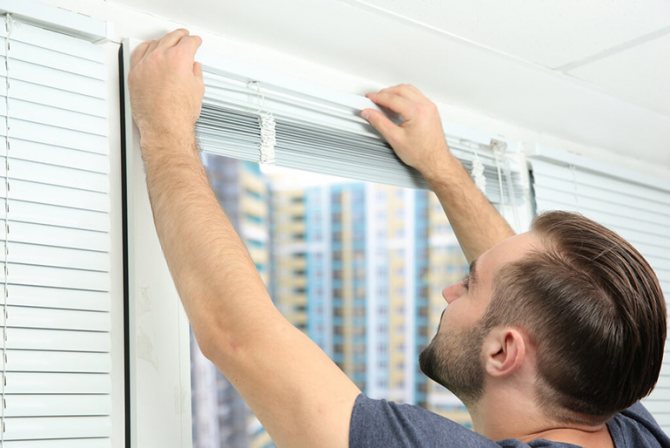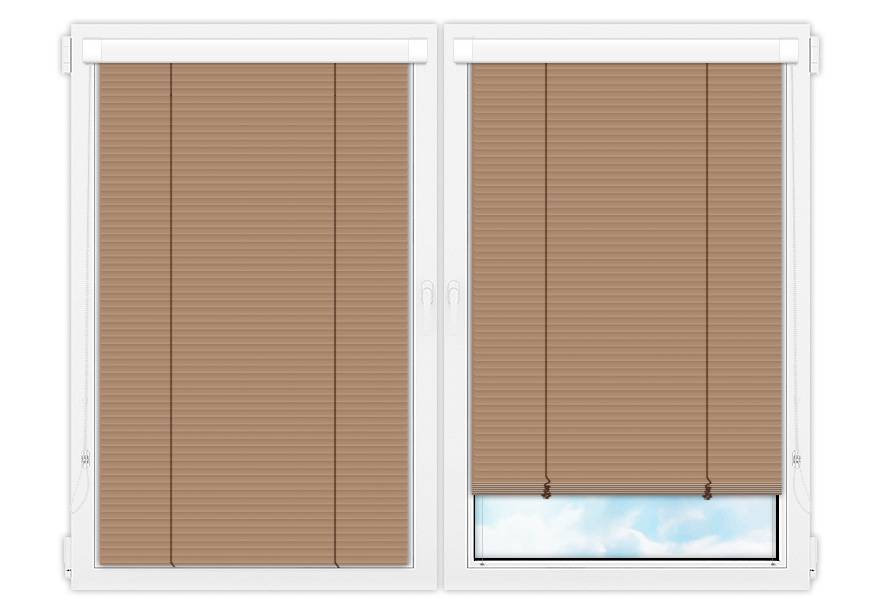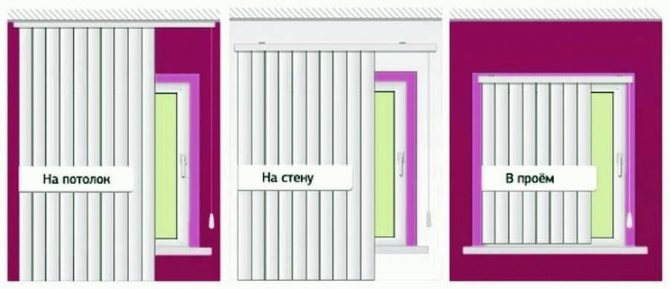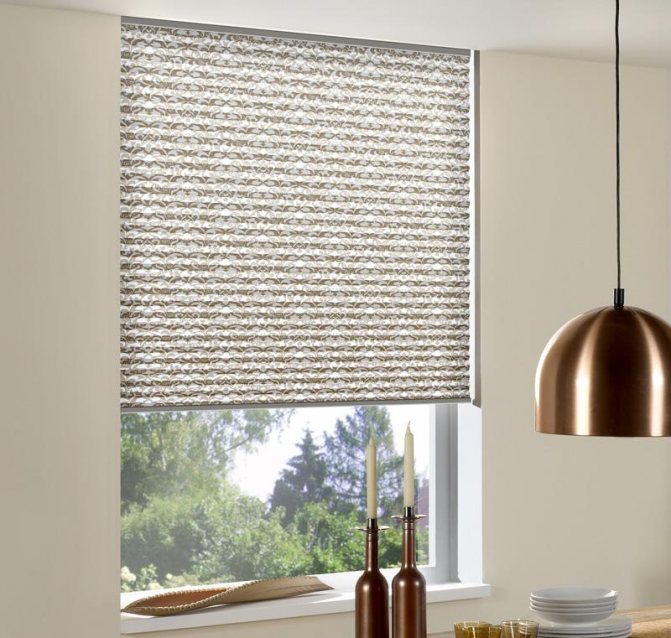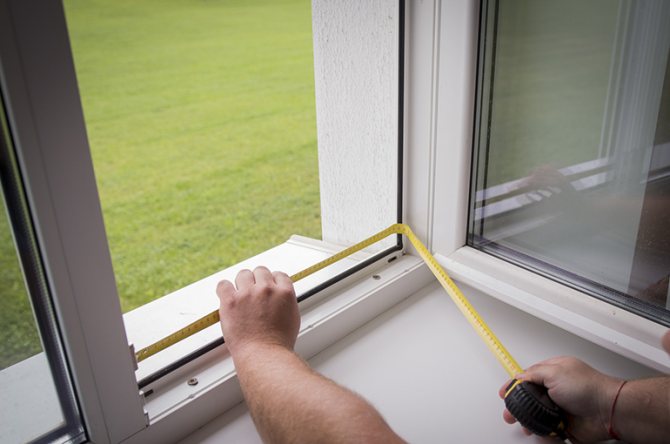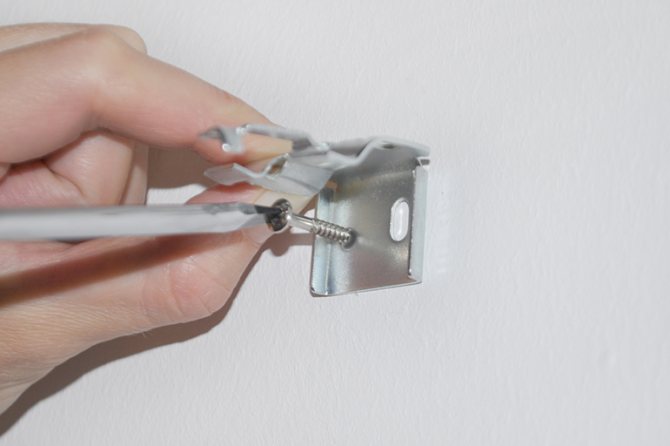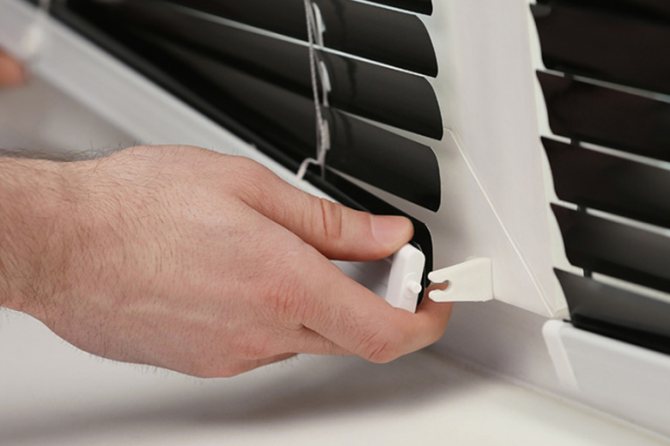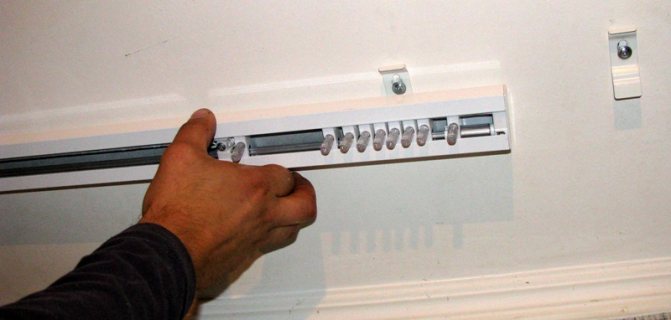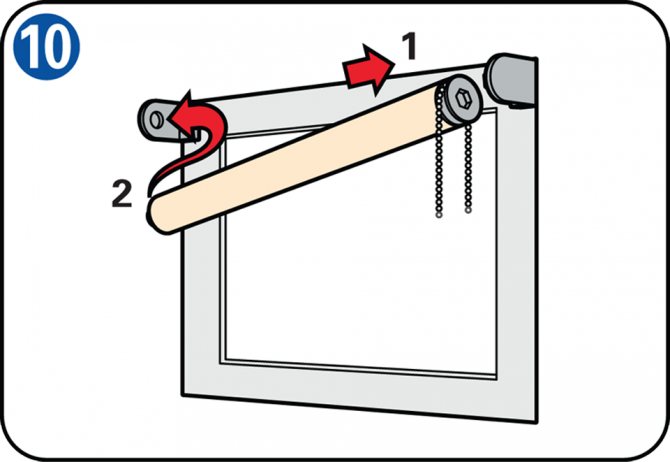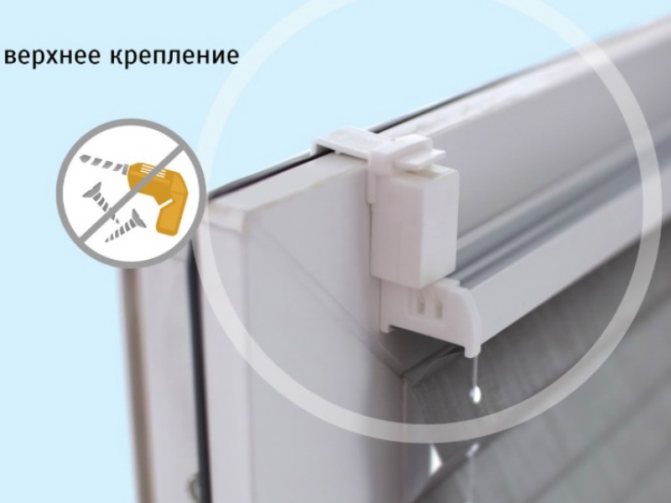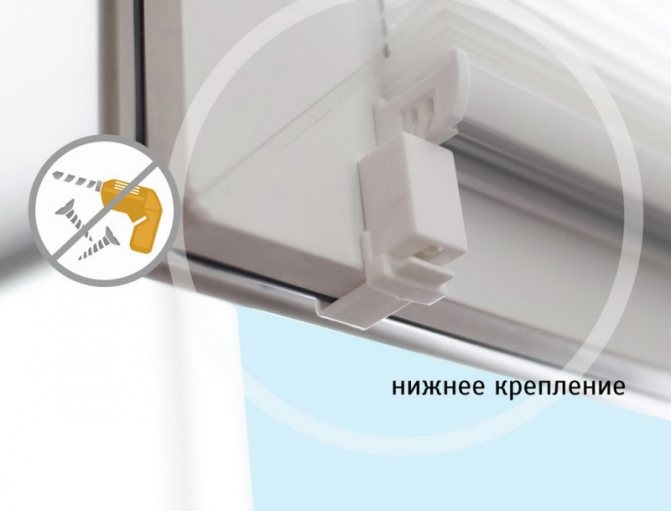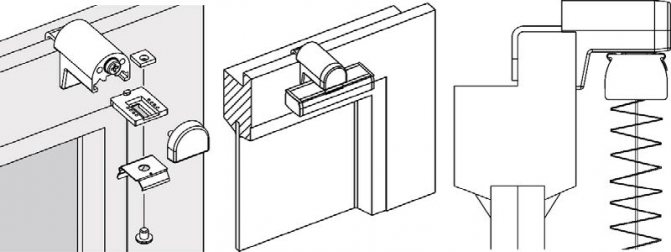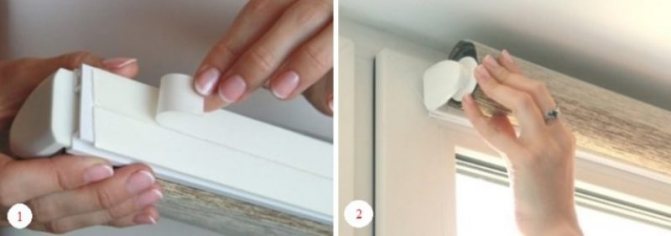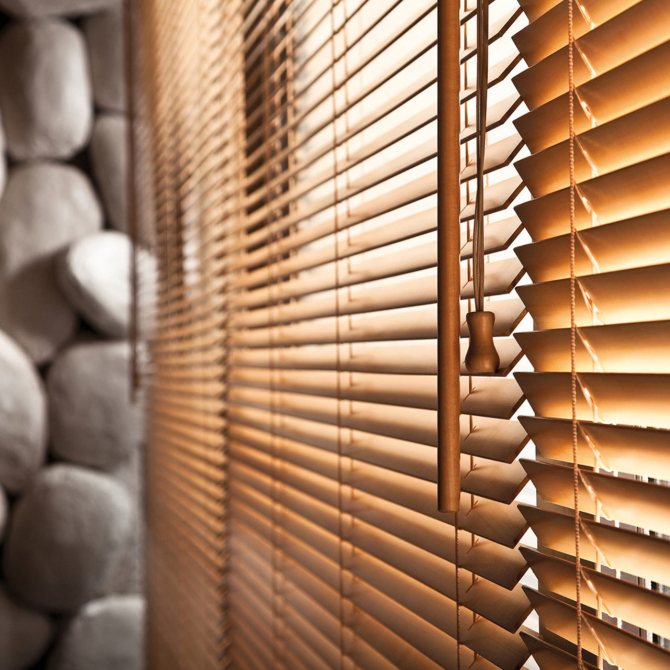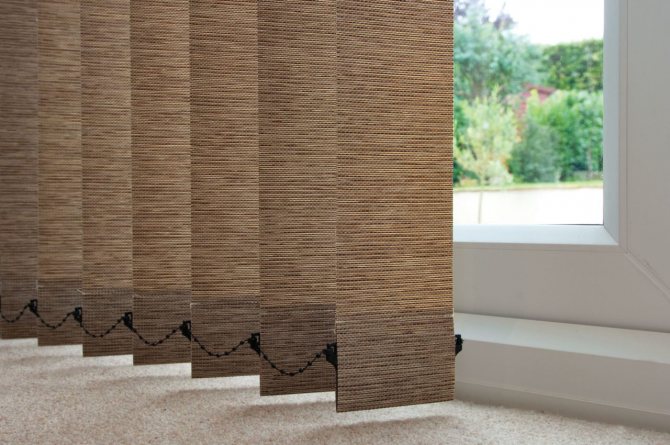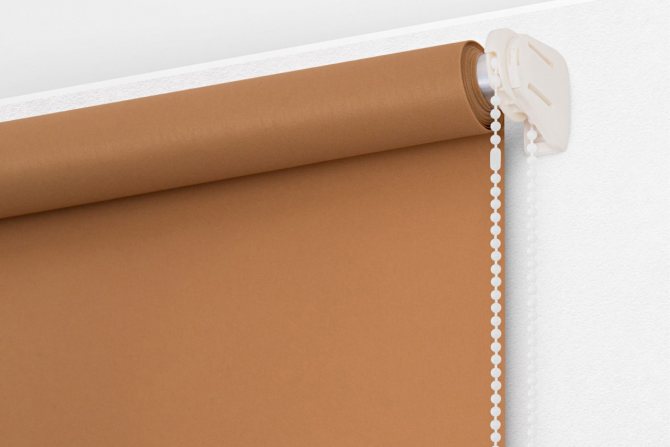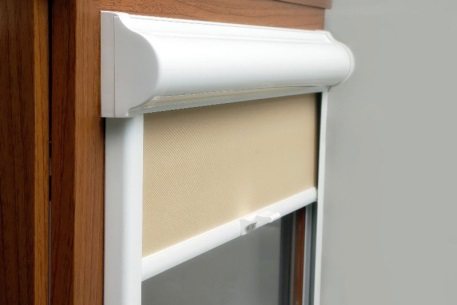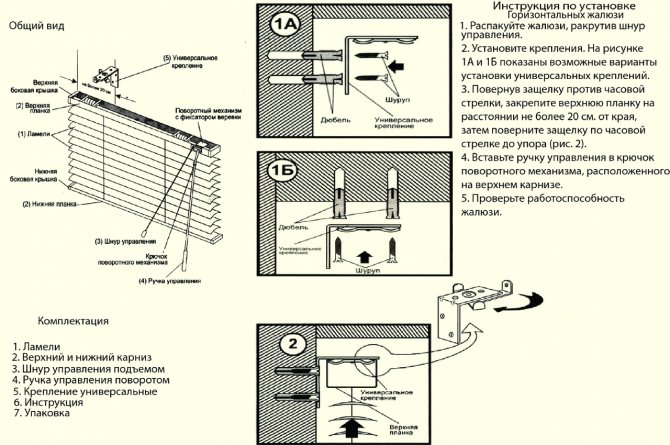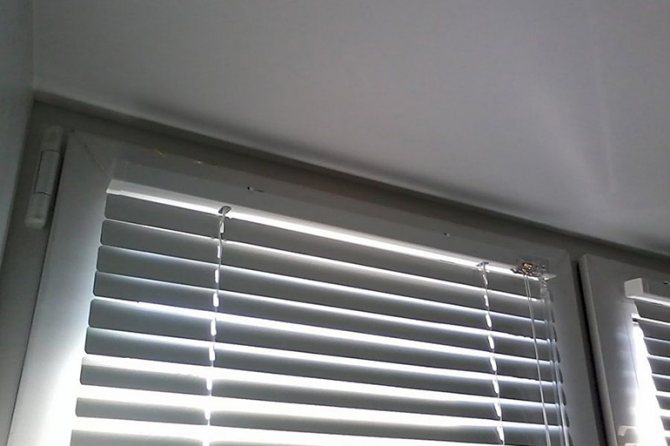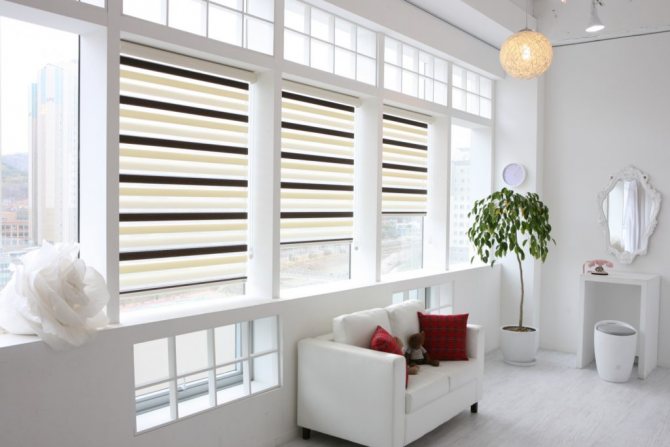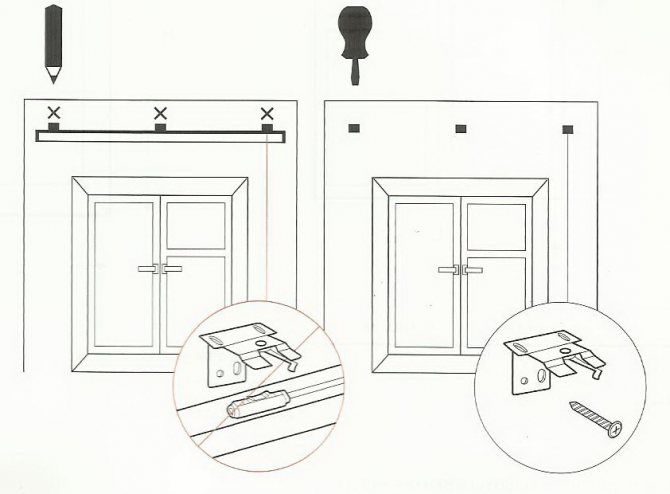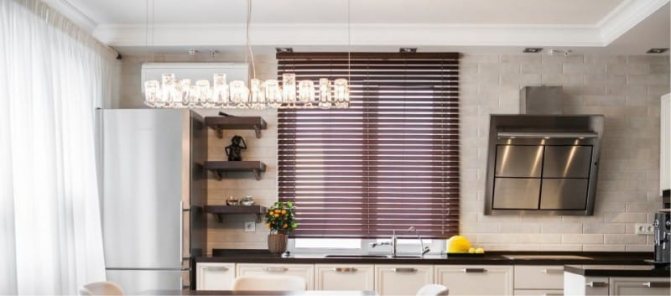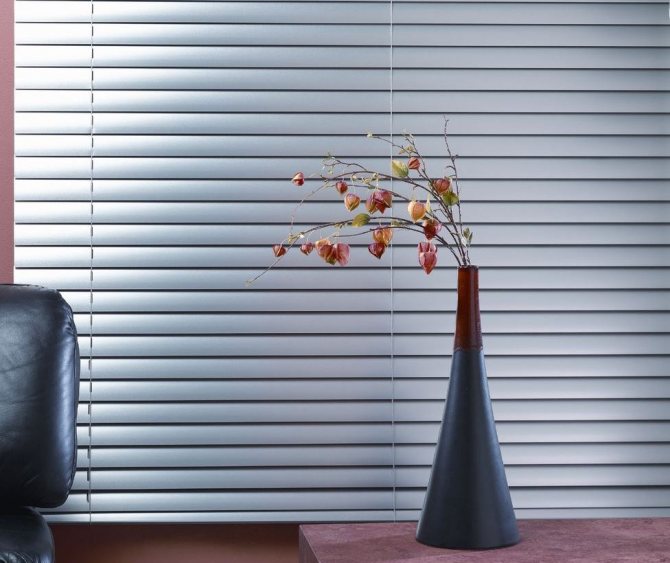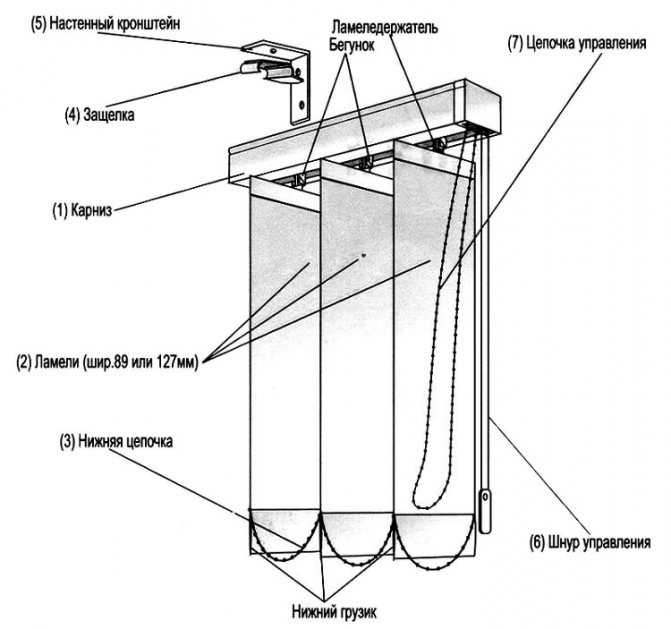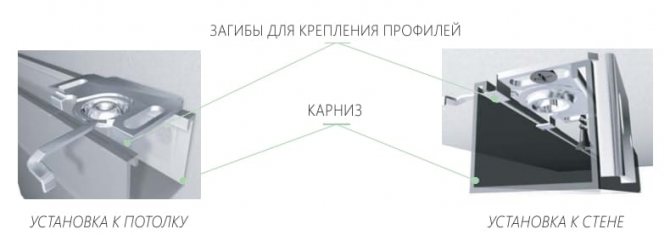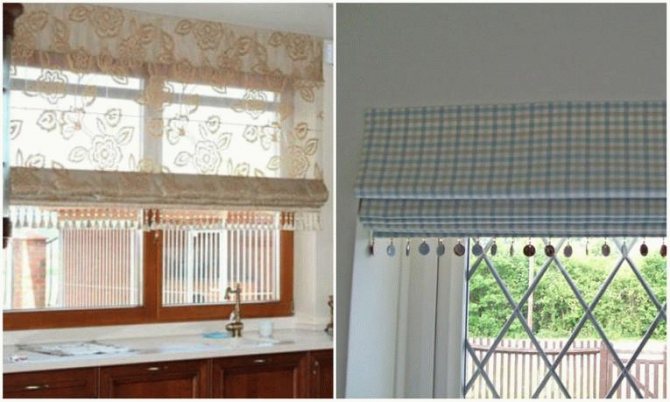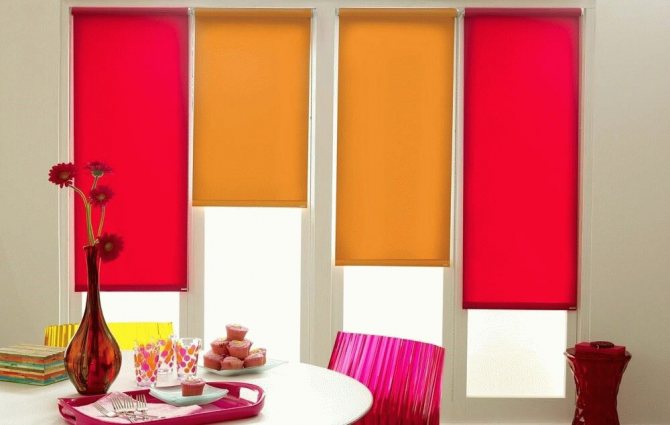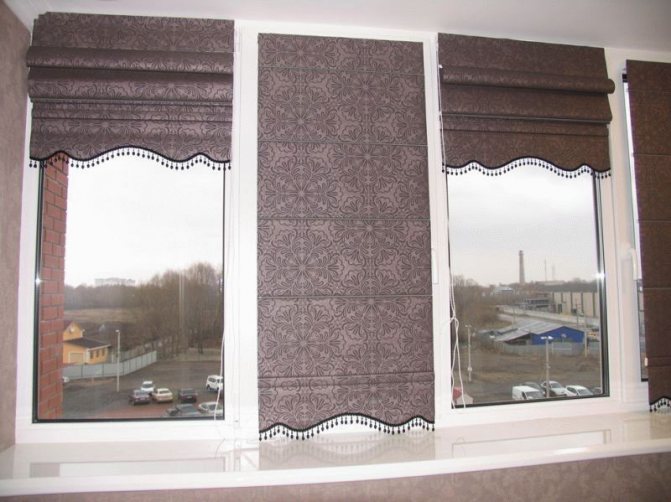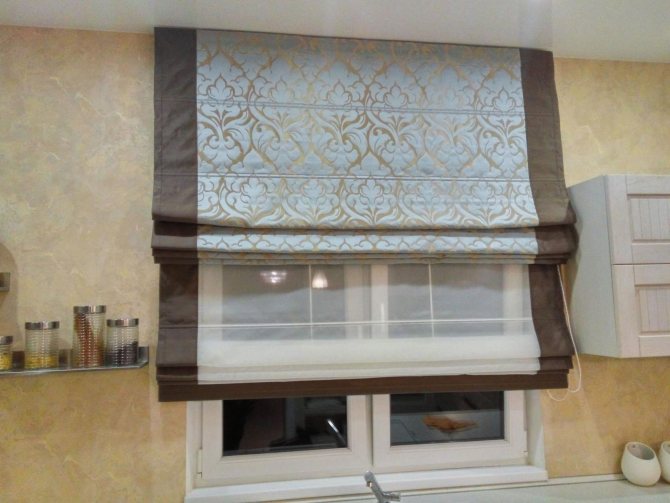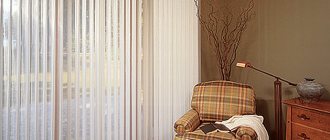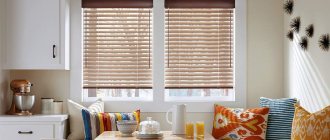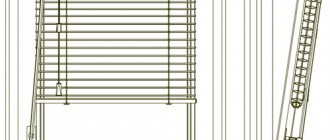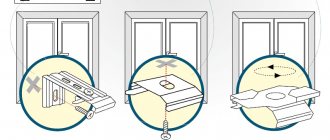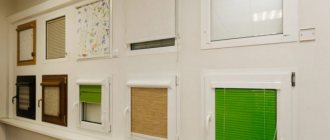They can be used both in the office and at home. The first question that arises when purchasing such blinds is how to assemble vertical blinds and hang them?
In fact, this is not difficult and anyone can handle it.
We carry out measurements
It is necessary to decide on the type of blinds (horizontal, vertical) and the method of their installation (on the wall, ceiling, in the window on the sash, in the window opening) before buying. And even until the moment you start measuring.
Because different installation methods require different sizes. Only with the correct measurements will it be easy to install blinds on plastic windows.
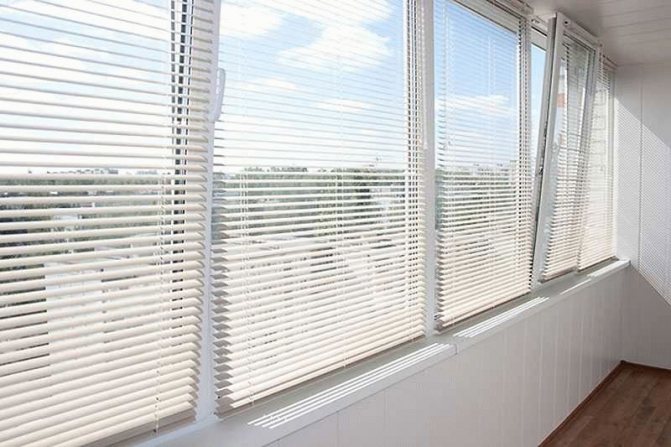
For everything to work well, you need to make the right measurements.
Another important point: you need to measure each window separately... Sometimes it just seems that they are exactly the same. Believe me, there is a difference. And the measurement results must be recorded and signed, which specific window you measured and which sash it is. Accurate and detailed records will help avoid confusion when purchasing and installing.
Into the window opening
Although the appearance of the products is different, when measuring there is no difference between horizontal and vertical models. If you are going to install blinds in a window opening, it is necessary to subtract 2 cm from its width on each side.
You can subtract 1-3 cm from the height of the opening. Such gaps are needed so that the canvas hangs freely in the opening and the lower edge of the lamellas does not rub on the windowsill.
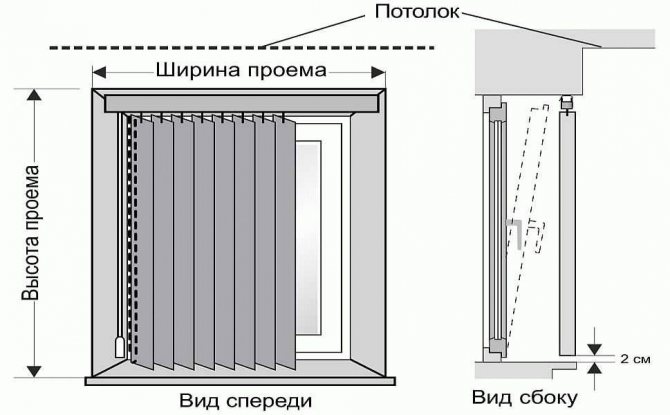

How to measure when installed in a window opening
Please note that it is possible to install blinds on plastic windows "in the opening" not flush with the edge of the opening, but deeper - at the glass itself or stepping back 5 or more centimeters from the edge. If the opening has a trapezoidal shape, the height / width of the opening will be less for the glass, so we carefully measure it.
And yet, in this case, it is better to put marks for installation even when measuring. Then you will know exactly where you will need to install blinds on plastic windows so that their dimensions fit perfectly.
Ceiling or wall
Here the measurements depend on your desires. The length of the blinds can be up to the floor or only up to the windowsill. Moreover, depending on the type of installation chosen, the lamellas can cover the window sill or not. So the length is whatever you like best.
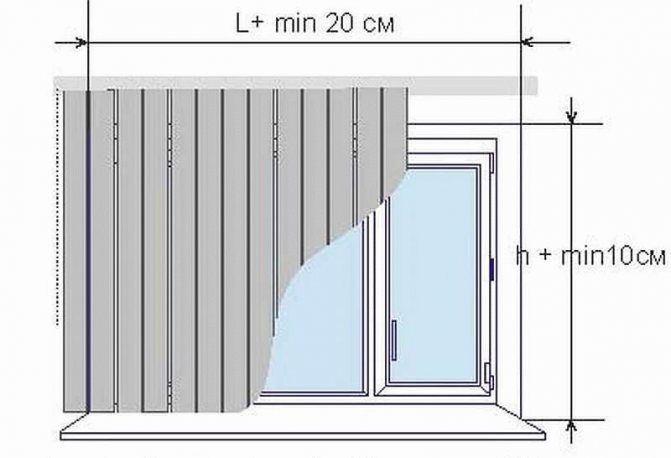

This is wall mounting
Expert opinion
Mikhailova Maria Vasilievna
Furniture store manager. Knows everything about comfort and interior
The width of the blinds with this installation method is wider than the window opening. How much wider depends on your desire, but the minimum entry is 5 cm on each side.
But if the window is in the same plane with the wall surface, you will need additional brackets, which are not included in the package: the lamellas must be spaced at least 5 cm from the glass surface so that they do not interfere with the opening of the sash for ventilation.
On sash
When installing blinds on a multi-sash window, there are two options - to put one device on each sash or order one long one for the whole window.Usually the first option is chosen - it makes it possible to open and close the sashes when the blinds are lowered.
If you choose this installation method, you will need to measure each leaf and record the results. The flaps can be different, so be careful.
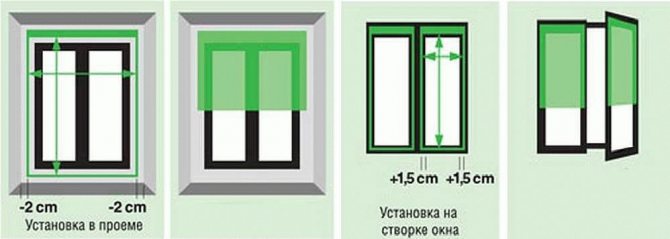

The option on the right is more convenient
The width of the blinds when installed on the sashes is taken 3 cm wider than the glass. When hanging, the lamellas are 1.5 cm over the profile. It is convenient and does not interfere with opening / closing windows. The length depends on the mounting location, but usually it is 5 cm longer than the glass height.
Once again, we draw your attention: we measure each sash!
Features and purpose of blinds
The main characteristic of blinds is simple installation, in which the products are quickly and easily fixed in the window opening. A convenient control process allows you to effectively change the level of illumination of the room.
When choosing blinds, one should decide not only on the appearance and material of the blinds, but also on the method of fixing them on a plastic window, so that their operation is as efficient as possible.
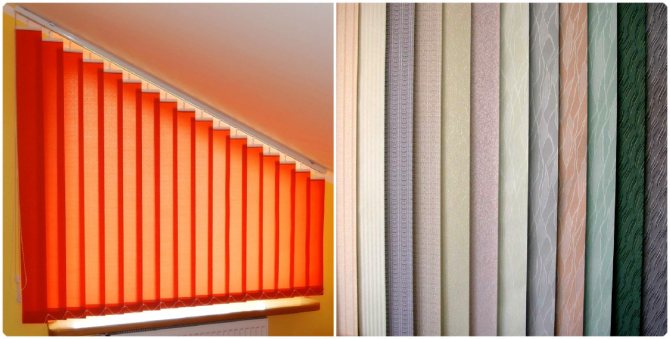

Wide range of fabric slats for vertical blinds
The main element of the blinds is the slats. They can be:
- Vertical or horizontal.
- Rolled or pleated.
- Fabric, plastic, wood, aluminum.
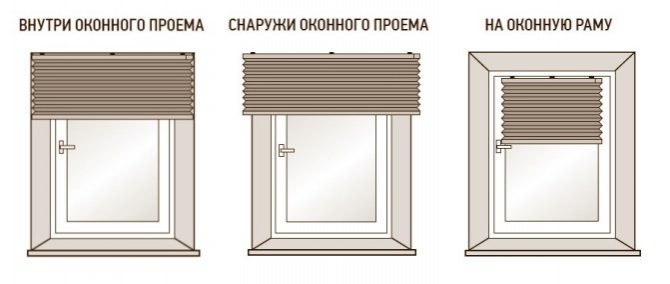

Fixation methods
The location method is different:
- Inside the window opening - in the overlay.
- On the sash of a plastic window.
- Above the window opening. Fixation is made to the wall.
Note! When choosing between the first and second method of fixing, the width of the window sill and the depth of the window opening are taken into account. In the third case, the window opening is completely closed.
More about types of blinds
The main function is to protect rooms and furniture from direct sunlight. Traditional curtains can also cope with this task, but the advantage of blinds in this case is that they do not interfere with the circulation of fresh air, and also allow you to adjust the light intensity in the room in a wide range - from complete darkness to filling the room with sunlight. It doesn't take much effort.
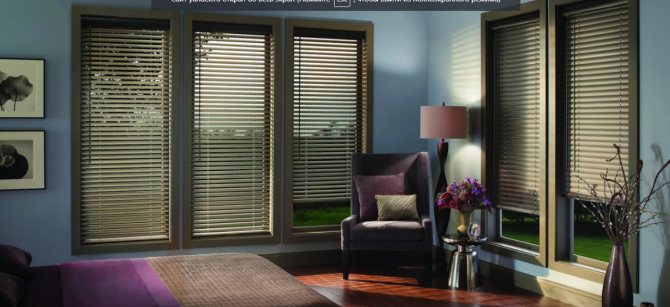

Blinds in the bedroom
Blinds can be used in many modern and some classic styles. Most of all, they correspond to the trends of minimalist interiors - they allow you to use free space rationally, do not require much space, and are easy to use and maintain.
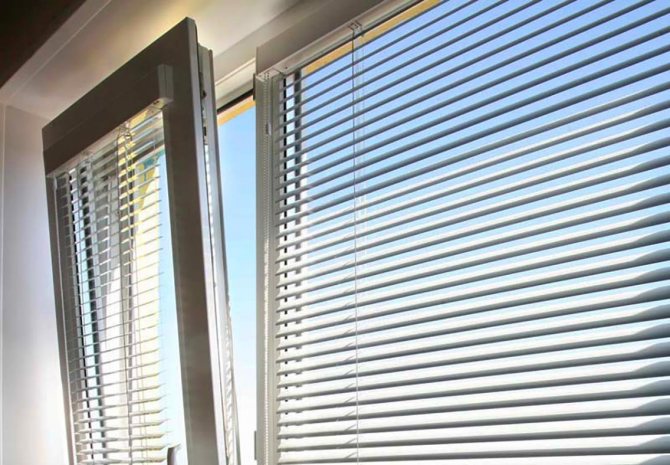

Horizontal devices do not affect the functionality of the window system
Table 1. The most common types of blinds
| Illustration | Description |
| A practical option, they reliably close the room from prying eyes and sunlight. Fixed to the wall or to the window sash. The second method is more practical, since it does not affect the functionality (opening, closing) of the window system. Most often, such blinds are made in the form of thin aluminum slats, therefore, they are popular in rooms with high humidity - in the bathroom and in the kitchen. The movement of the canvas is possible only up / down. The intensity of the illumination is regulated by the movement of the lamellas. |
| Presented by fabric vertical lamellas of the same width. They are fixed to the wall in such a way that it is possible to open the sash for ventilation. The control method involves not only changing the angle of the lamellae, but also moving them to the left, right, or in both directions (like a curtain). |
| They are represented by a solid, dense canvas that shades the room. When opened, the web is rolled into a roll. Used together with light curtains. |
| A practical option, involving the installation of the box in the frame, which does not interfere with the free opening of the window sashes. |
Blinds prices
Jalousie
How to install blinds on plastic windows: attach to a wall or window opening
The first step is to apply the markings. We install brackets in the cornice. We place them on the right and left so that they do not interfere with the operation of the blinds. The installation height depends on the selected product length.
We apply the curtains, mark with a pencil on the wall the places for installing the fasteners in the brackets. If we mount horizontal blinds (they are light and hardly create loads), it is enough to put one screw / dowel at a time. Vertical ones are heavier, so you need to install all the fasteners from the kit.
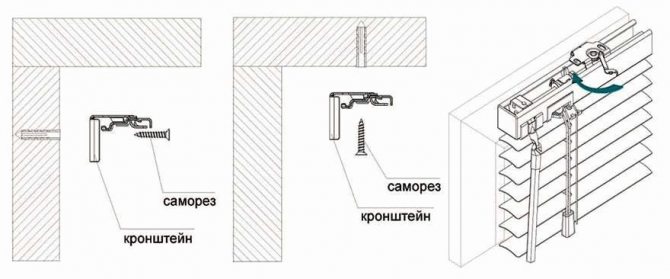

Installation of blinds on the ceiling and walls is the same
There is also a second way. Draw a horizontal line at the selected level using the building level, try to avoid tilting - this will affect the blinds (skew).
Attach the bottom of the bracket to this line, using a pencil to mark through the holes for drilling. If the length of the eaves is more than 2 m, an additional bracket is needed to increase the rigidity of the structure, which is fixed in the middle.
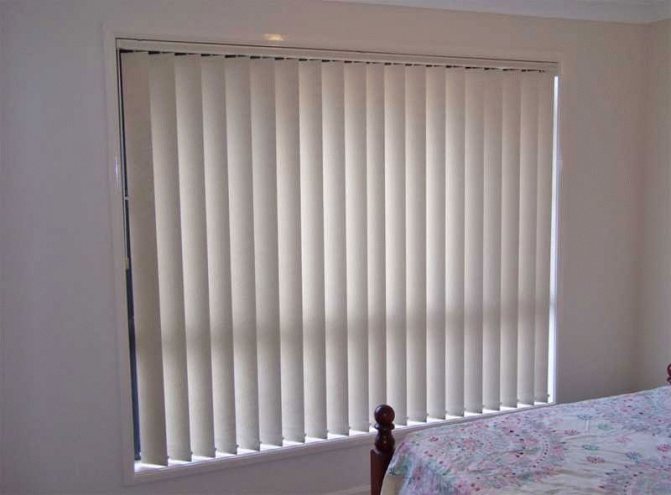

This is what vertical blinds installed in the window opening look like.
When fastening to brick or concrete, we drill holes in the wall or ceiling at the marked points. Drill or hammer drill - who has what in stock. The drill diameter depends on the size of the dowels. They usually come in a set, but you can put your own.
We insert expansion dowels into the finished holes, carefully hammer them in with a hammer. We put brackets, fasten them with screws or nails (if using a dowel-nails).
We install the cornice on the brackets, insert the plugs on the sides. For horizontal blinds, attach a rod (handle) to control the swing mechanism.
To do this, directly into the mechanism itself, install a special hook (included), attach the tip of the rod to this hook.
Bracket types
They are divided into ceiling, wall and universal - it depends on the surface to which they are attached. They are usually made of steel or plastic, but there are also other metals or wood.
By design, they are divided into four types.
- Fixed. They are used in cases where a rigid installation is required.
- Inclined. Such supports change their angle of inclination, which often does not exceed 15 degrees.
- Polyarticular. Made of two parts, they have the ability to change the angle of inclination and rotation.
- Swivel and tilt. Flexible arms that tilt, swivel and change length.
Do-it-yourself installation of blinds on plastic windows: step-by-step instructions
Self-installation of different types of blinds on plastic windows is a troublesome process, but economical - on the one hand, and interesting and informative - on the other. Blinds in the house are a unique decor element that allows you to transform plastic windows and decorate the interior as a whole.
But there is one "but". Blinds cannot be hung in two minutes, like cotton or tulle curtains.
A whole arsenal of knowledge and practical skills is needed here. Installing blinds with your own hands on plastic windows takes time, certain knowledge and skills.
Expert opinion
Mikhailova Maria Vasilievna
Furniture store manager. Knows everything about comfort and interior
If you are new to this field, take your time, learn the basics of construction, installation methods and fixing rules, and only then - "into battle".
The ideal option is to invite qualified professionals. The process will be quick, but not financially beneficial. Doesn't fit? You do not know how to install blinds on PVC windows, but want to do it yourself? Then we propose to install them with your own hands, having previously familiarized yourself with the basic rules and technology.
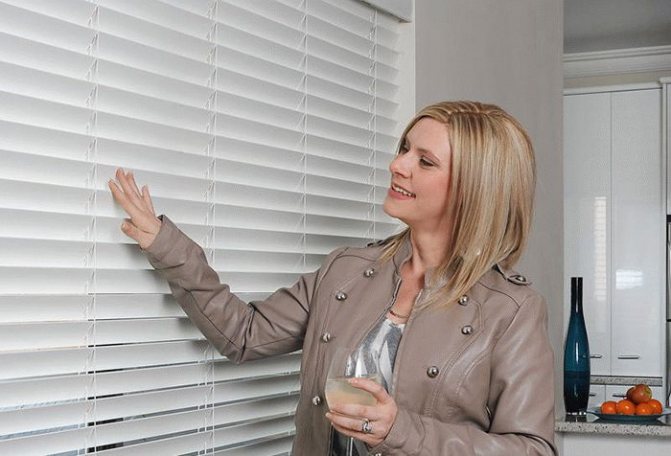

Types of blinds and selection criteria
With the help of blinds, they regulate the flow of sunlight into the room and hide what is happening inside from prying eyes. This is a modern type of curtain, consisting of a cornice, slats and a control mechanism.
There are different types of blinds, differing in size, design and material of manufacture.
Horizontal
This view is a design in which thin plates are arranged horizontally. Using the control mechanism, you can change the angle of inclination of the lamellas, i.e. regulate the required amount of light in the room, or fold them and fully open the window.
Previously, horizontal blinds were mainly installed in offices, but modern models fit well into the interior of the kitchen and other premises. Such curtains take up little space, they are easy to care for, they visually expand the space.
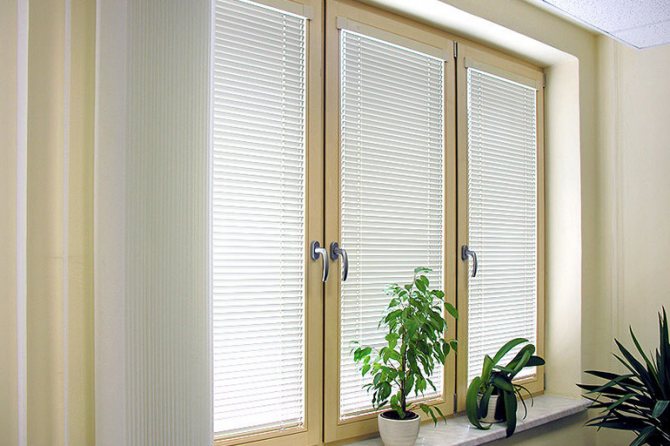

The disadvantage is that in the presence of drafts, the lamellas can hit the glass.
If used improperly, the strips twist, bend and break.
Vertical
In such designs, the lamellas are fixed in an upright position. Their upper parts are fixed in the cornice, and the lower ones are connected with a light chain. This is a popular type of window decoration in different rooms. Vertical systems open to the right / left or extend from the center to the edges.
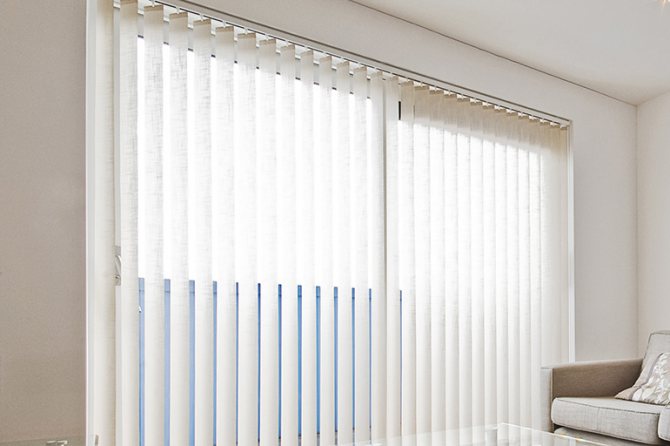

Thick fabric or fiberglass is used to create these curtains, so they look more attractive compared to metal or plastic structures. Vertical lamellas do not break, do not twist, do not fade in the sun, and have a long service life.
Such blinds visually increase the height of the room; there is practically no noise when they are opened / closed.
Cassette
This is a kind of roller blinds that have been specially designed for PVC windows. The basis of such models is a solid canvas, which, if necessary, is wound onto a shaft. The blinds are lowered and raised using a special mechanism.
Cassettes are available in corner, flat or round. They can be controlled by a chain, a spring or an automatic system. The first option is more reliable and more durable than the spring system. The electronic system allows you to control the curtains remotely, therefore it is used on hard-to-reach windows.
Cassette structures can also consist of horizontal slats. Most often they are made from bamboo, but there are models with plastic or aluminum plates. Unlike the canvas, they are not folded, but assembled by a ladder.
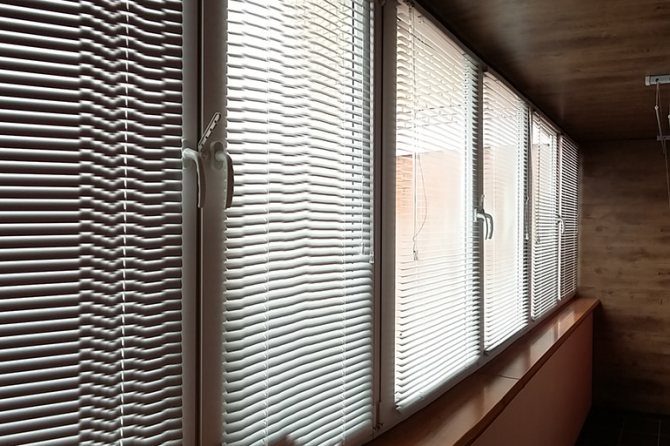

This is a great option for the kitchen:
- the cassette protects the canvas from premature wear;
- the blinds are neat and do not take up much space;
- the canvas hidden in the cassette will not get dirty during cooking.
Roll
Roller blinds help to quickly, easily and inexpensively arrange a window opening. Due to the simplicity of their design, they can look unattractive, but if they are used in combination with the usual curtains, then this drawback can be easily eliminated.
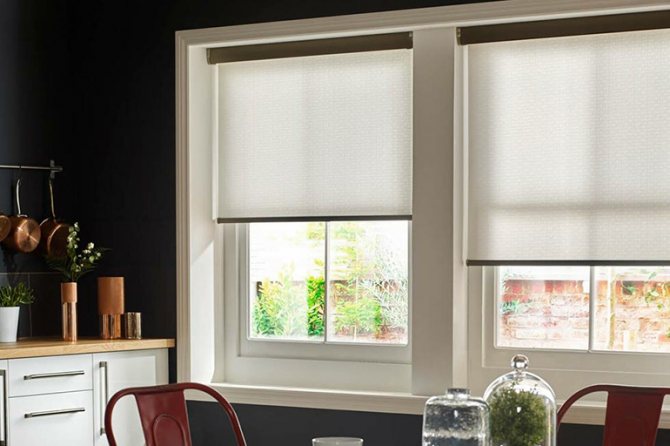

Such a design is justified in the case when, in addition to protecting from the sun, it is necessary to close the room from prying eyes.
If necessary, the window is completely covered.
Blinds mounting options
The design of blinds is a complex mechanism that requires not only a share of responsibility on the part of a specialist or "self-taught", but also a certain baggage of knowledge, skills and abilities. There are many types, they all have common installation basics, but each of them has some nuances that are important to know about.
If you take into account the subtleties of each type of blinds, they will last more than a dozen years without reminding you of themselves.
Before choosing methods of fastening, pay attention to the condition of the walls, their architectural features.
You can fix the blinds in one of three ways:
- into the window opening;
- on the window sashes (each separately);
- overlap.
Which way to choose? The choice depends mainly on the wishes of the owner, but also on the design features of the window.
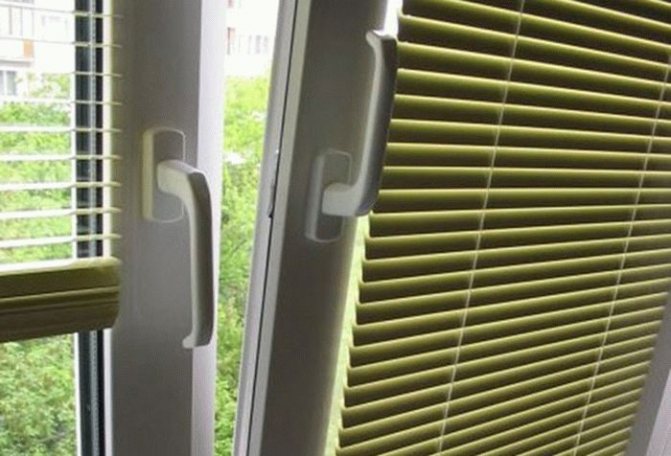

Eaves installation methods
Cornice is the main part of any kind of blinds. Before starting its installation, you must study the instructions, which describe the procedure for performing the work. The kit always contains the necessary fasteners.
No drilling
This method allows you to quickly mount and dismantle the blinds, while the window frame is not damaged. The cornice is attached to special brackets installed on the upper part of the window sash. They can simply be put on the sash; in some cases, double-sided tape is used to secure them more securely.
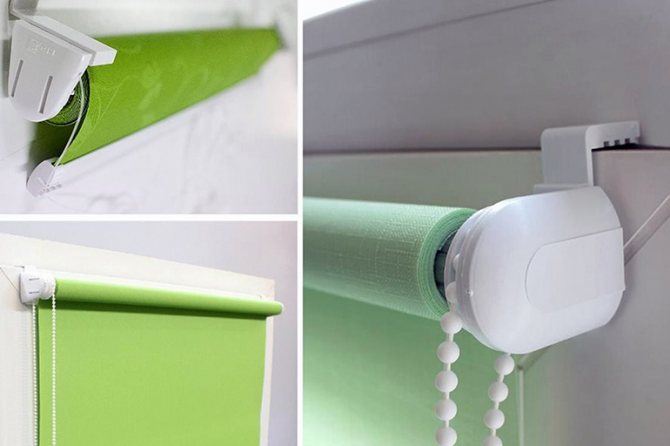

With self-tapping screws
This is a simple and affordable mounting option that provides reliable fixation of the curtain rod to the window profile. It is necessary to choose the correct location of the cornice, so that during its installation it does not get into the glass with a self-tapping screw.
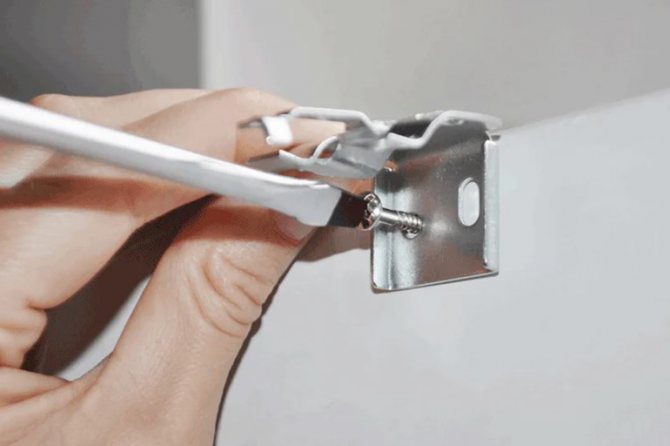

To the wall or ceiling
The cornice is screwed to the ceiling or wall with dowels and screws. In the marked places, holes are made up to 5 cm deep. Dowels are inserted into them, brackets are applied and fixed with screws. This is the most reliable way.
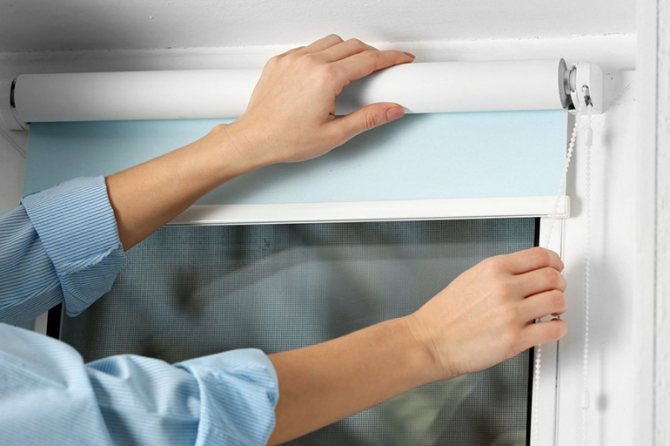

What do you need to know about windows to avoid mistakes?
Let's pay attention to a common mistake that occurs if you incorrectly approach the issue of installing blinds on plastic windows.
If you installed horizontal blinds, which look like a solid canvas, on plastic windows to the slopes, be sure that you will be guaranteed discomfort when opening and closing each of the shutters. This method is incompatible with blinds in the form of a solid curtain, since each time you open a window or window, you will have to collect them up, and then lower them again.
This is a very troublesome business, especially in the kitchen, when plastic windows for ventilation are opened very often.
The way out is to fix the blinds not in the slopes, but on the window sashes.
Interframe curtains
Interframe curtains are only used for double frames. Installation of blinds of this type is somewhat more complicated than the previous ones, and the process itself will result in an inevitable violation of the integrity of the profile: you will have to drill at least two holes through which the handle and cord will be ejected to control the system.
The curtains themselves are mounted in the inner sash, more precisely, in its upper part, and the bracket is mounted directly to the upper profile. Installation of the structure is in many ways similar to working with horizontal blinds.
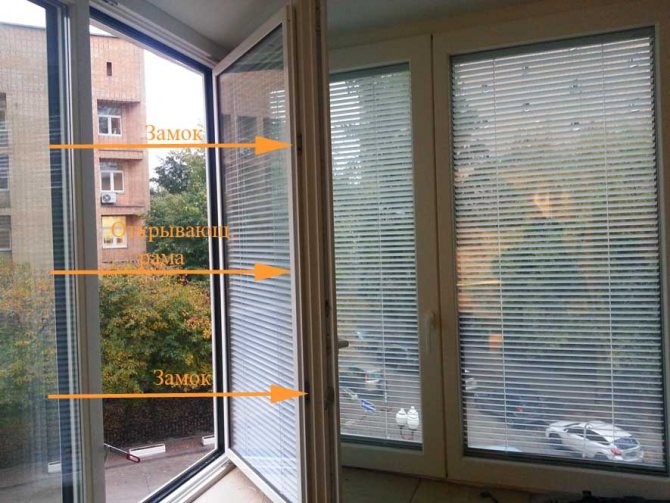

Interframe curtains are installed in double glazed windows
Do-it-yourself installation of the system is carried out according to the following algorithm:
- The window frame is unwound and the blinds are applied to the inner sash. This is used to check if the dimensions match.
- Markings are made for fastening, as well as the points of the cord outlet and the control handle, after which holes are drilled with a diameter of about 5 mm.
- The brackets are inserted into the calipers, the cords and control knobs are led out, with the cord through the bottom hole.
- Interframe blinds are attached to the sash with special interframe brackets.
- An adapter is installed on the frame, and a control handle is connected to the flexible outlet.
- The control handle and cord lock is installed.
- The frame rolls back up.
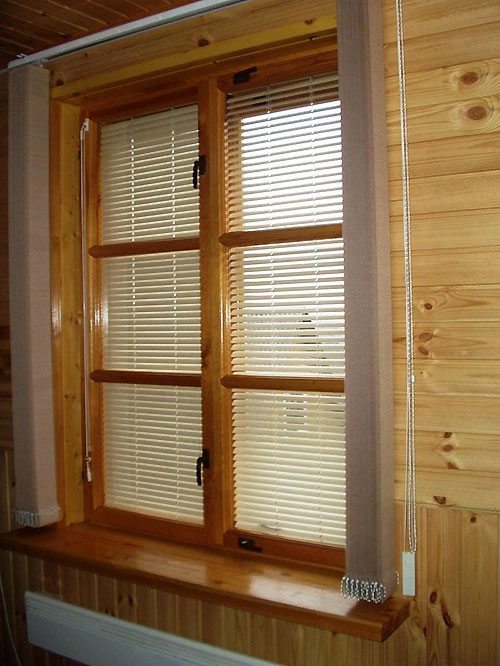

The blinds control is led out through the frame
As you can see, the technology of installing blinds on plastic windows without drilling is completely inappropriate here. The principle itself resembles the installation of all other design options with the only difference that you have to disassemble the frame, screw the bracket into the interframe space, and bring out the controls through the drilled holes.
Read on the topic: DIY vase decor: decoration features and modern design (+55 photos)
How to install vertical blinds?
Installation of vertical blinds takes place using brackets.
- Make a markup, marking with a pencil the places where you plan to hang them. It is desirable that the distance between them be from 30 centimeters to half a meter.
- Fix the curtain rod in the brackets according to the instructions supplied with the curtains and accessories.
- There is a clicking sound when properly installed in the brackets.
- Do the same with the slats, setting them in the sliders until you hear a click. You need to hang the lamellas sequentially if they are with a photo print or pattern.
- Connect the lamellas with a chain from both the inside and the outside.
- Check the operation of the entire mechanism.
Installation of vertical blinds has one, but a very significant nuance. It is important to consider the width of the lamellas. If it has dimensions greater than 160 cm, then the number of brackets used must be increased to at least three.
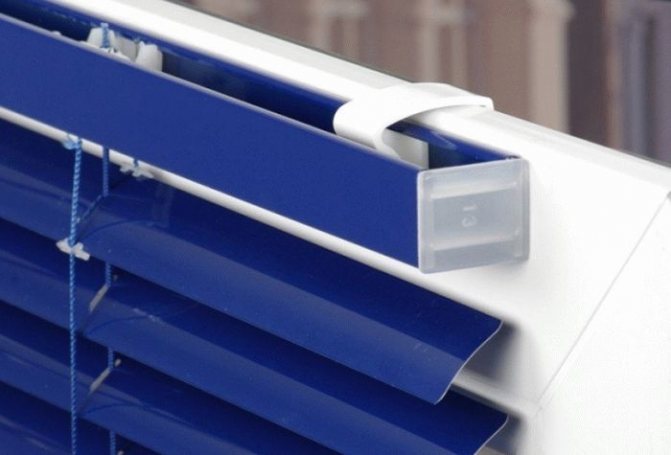

Where to mount
It is not difficult to hang vertical blinds on your own, but it is important to decide where to attach them, there are only two basic installation options:
- on the ceiling or on the upper horizontal slope of the opening, that is, the cornice is installed on a surface perpendicular to the plane of the window;
- on the wall - the fastening is done on the upper or side walls of the window, here it is necessary to choose the right brackets so that there is a sufficient extension of the canvas from the vertical plane, and the lamellas do not cling to the wall.
What should be considered?
Do you want the installed curtains to serve for a long time, and their mechanism and fastening do not lose their original functions?
Advice 1. When buying blinds, try to ensure that all components are of high quality.
Advice 2. Select the adjustment mechanism taking into account the convenient side during operation.
Tip 3. Make sure that when the window is fully opened, the blinds are fully folded.
Advice 4. Turning the handle should not limit the mechanical impact on the elements.
Tip 5. Perform maintenance in a timely manner.
All ingenious is simple. Now you are convinced of this. It is not difficult to install blinds on windows with your own hands if you have detailed instructions at hand. Choose a convenient way for yourself, use the suggested instructions, and tomorrow the windows will “thank you”.
Purchased or homemade?
A wide variety of models of roller blinds, roman, pleated and other compact-gathering curtains on sale does not necessarily guarantee that there is an ideal product among the offered range. The main characteristics of industrially produced options are:
- standardized sizes. Typical size range - length, width - is designed for the popular dimensions of metal-plastic and wooden windows;
- neutral colors. For the most part, ready-made curtains have calm, subtle tones that suit different interiors. Colored and printed items are more expensive;
- use of non-woven or woven synthetic materials as a base fabric. Their advantages are resistance to ultraviolet radiation, ease of cleaning, durability, strength. It is the synthetic nature that is considered the main disadvantage;
- standard open / close mechanisms;
- typical finish or lack thereof.
For many users, all of these features are pluses. But with a non-standard window size, a desire to create an individual design, a desire for natural materials, it is better to try to order a suitable model or create do-it-yourself roller blinds for plastic windows.
Fasteners without drilling
If you are going to hang blinds on a plastic window with your own hands and do without drilling, then the choice will have to be limited to small and fairly light models, the weight of which can withstand:
- magnetic mounts;
- mounting double-sided adhesive tape;
- reliable double-sided tape (automotive);
- Velcro fasteners Command (or other firm);
- special brackets that have various options for fastening to the frame: they are fixed on tape, tape or glued plates, screwed with self-tapping screws or cling to the upper part of the opening sash.
Cassette roller blinds or system Uni
They are attached directly to the sash of a plastic window using tape, tape or Velcro.
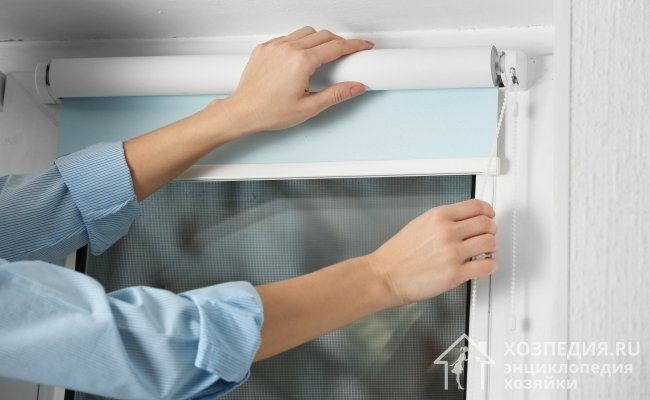

Roller blind, fixed without drilling on the opening sash of a plastic window
Roller blinds Mini
For fastening, they also use double-sided tape (adhesive tape, Velcro), on which special platforms are glued to the frame. The canvas is fixed on them with brackets. When placing roll cloths on the opening sash, magnets are additionally installed to attract the blinds.
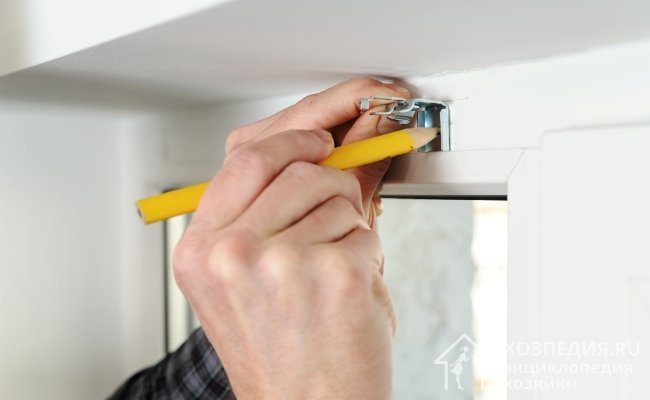

Screwing the bracket with self-tapping screws to the sash of the plastic window must be done carefully, as there is a risk of damaging the sealing gasket
Roll curtains
Can be mounted on brackets, tape, tape or Velcro.
Before gluing tape or adhesive tape, the frame must be thoroughly washed, wiped dry and degreased with an alcohol solution. If you will be using Velcro, follow the instructions on the package.
Horizontal systems with wood (bamboo), aluminum or plastic strips (lamellas)
You can hang the blinds on the window using special clips that are attached to the upper and lower parts of the sash, and a cable is pulled between them.
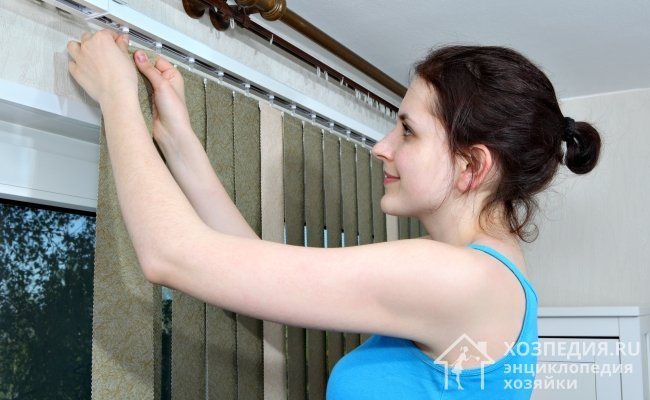

Horizontal systems are hung over the entire width of the window or separately on each fold
For a complete picture of how to hang blinds without drilling using various mounts, we suggest watching the following video:
All blind systems, as a rule, are supplied with detailed manufacturer's instructions, installation diagram and a set of necessary fasteners.
Choice of design and materials
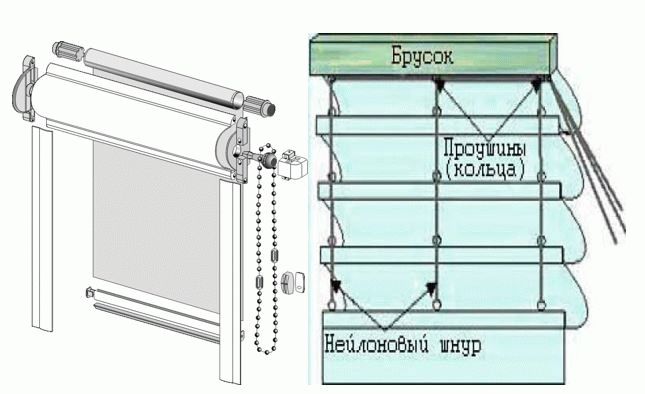

Before choosing a design, it is important to determine the complexity of the work and the possibility of its independent implementation. Using ready-made parts - a pipe with brackets-holders, a mechanism for twisting the fabric into a roller - you can "swing" at the classic version.
If there are no such parts, or it is preferable to reduce manufacturing costs, it is better to stay on Roman blinds in the simplest version.
Comparing the given schemes, it is easy to notice the difference in the number and complexity of the elements. So, both options require:
- a piece of fabric along the length and width of the window;
- a tube for wrapping fabric and a bottom strip for roller blinds, a base strip and intermediate (for forming folds) for Roman blinds;
- brackets or other fasteners for pipe or base plate. Important: the pipe for the roll-up model must be able to rotate, the bar is fixed immovably;
- assembly mechanism. In the case of the roll type, these are gears that rotate the winding pipe when pulling the ball chain. For Roman blinds, the simplest method of pulling the cord through the rings (eyes) is used.
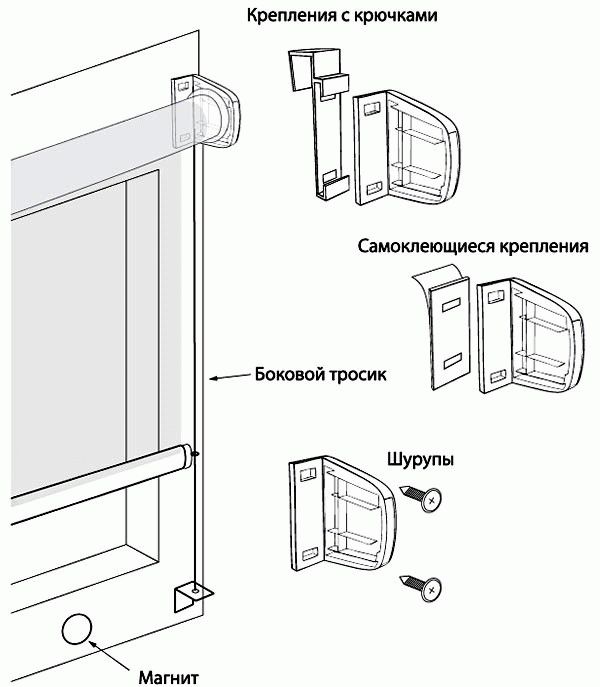

Additionally, you can use special guides that do not allow the product to "dangle" when the window is open for ventilation, or special clips.
Material selection
Depending on the purpose - decor, high-quality shading, minimal window shading - different types of materials are chosen:
- textile. It can be natural (cotton, linen, silk, mixed fabrics, synthetics) of various density, texture and color;
- high-quality thick paper on a fabric or non-woven backing. In fact, this is a roll wallpaper or their analogue;
- composite materials - a mat, a mat made of straw, bamboo, thin strips and others.
For the sunny side, where high-quality protection from direct rays and heat is required, dense materials are preferred, including multi-layer ones. When planning to use paper rolls, it is important to remember that with active exposure to ultraviolet radiation, they can quickly lose their density and strength, the same applies to the action of moisture.
Elegant mixed fabrics of light structure are suitable for window decoration.
DIY roman blinds
Cutting and sewing in this case differ little. The main difference is the formation of folds. You can make the folds soft by simply stitching them in, and you can create "pockets" for the planks. The second option provides greater ease of use and uniformity of folds.
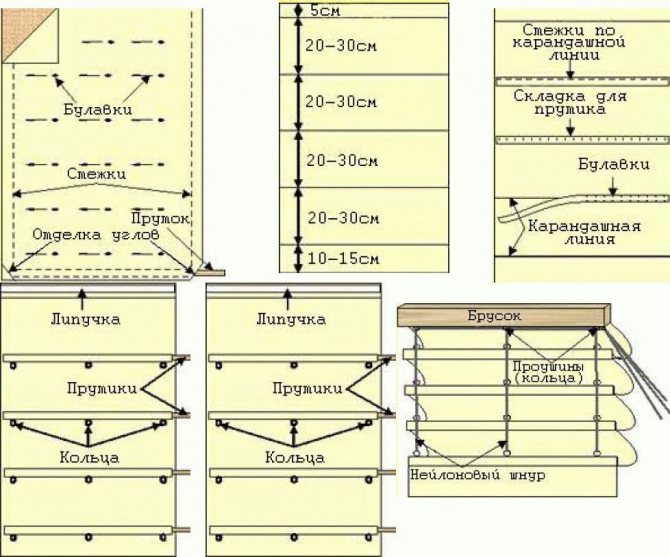

Below is a diagram of sewing and forming folds with "pockets" for reinforcing strips.
When calculating the length of the cord in this sewing option, the main thing is to remember the difference for each of the two / three fragments. It is convenient to lay out the curtain on the floor in a straightened form, estimate the position of the future wall cord holder and measure the required amount.
Nice and useful additions
For people with skills a little higher than the simplest household, various options for additions to homemade roller blinds and roman blinds may be interesting.
Drive for roller blinds do it yourself
Various electromechanical devices are used as a drive. The simplest of them are a chain or gear wheel connected to a twisting mechanism powered by a finger-type battery.
A master class on creating such an automatic drive will show how to make a convenient device for raising and lowering roller blinds from scrap materials in a couple of hours.
There are also simpler options for quickly lifting and lowering the fabric without using standard devices. Such a mechanism for do-it-yourself roller blinds is based on the use of a regular cord and a standard round tube-rod for curtains.
Advanced electricians can make do-it-yourself electric roller blinds based on small motors, including those made in China. Sellers from the Celestial Empire also offer ready-made kits for automation, but it is more interesting - and more reliable - to make such a mechanism yourself.
Expert opinion
Mikhailova Maria Vasilievna
Furniture store manager. Knows everything about comfort and interior
Guides for roller blinds do it yourself
If you do not want to buy additional side guides for the curtains, but the thought of the curtains sagging while opening the window is not encouraging, you can try to install homemade guides.
For this, a U-shaped profile is used, which one side is mounted directly on the window frame. In order not to break the tightness of the frame, it is better to use double-sided tape for installation.
When creating homemade curtains, the position of the profile is selected individually. It is important that the bottom bar moves freely up and down in it as the fabric is rolled into a roller. For the industrial production of curtains, it is worth focusing on the parameters of the product.
Additional decor
When decorating a window, craftsmen use a lot of interesting ideas, a photo of some of them is laid out below. The main "load" falls on the lower part of the curtain during the upper twisting or a variety of decor of the main fabric and tacks.
Most often, the emphasis is on color.
Types of blinds and how to choose them?
The modern market offers many types of blinds. They differ from each other in size, shape, direction of the strips themselves, material of manufacture and even in color.
In general, there are three main types:
Horizontal. This type is most suitable for living quarters. Such blinds can be mounted both inside the window, on each of its sash, and outside, closing the entire window. Such blinds are perfectly combined with curtains and practically do not occupy the window sill space.
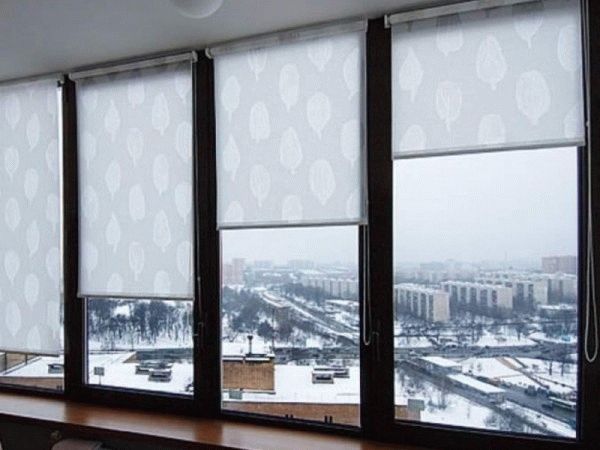

Vertical. The difference between this type of blinds is that they can be fixed not only to the window itself along its outer part, but even to the ceiling.
They create an adequate replacement for tulle curtains. However, this type creates "office", and therefore is used for residential premises not so often.
However, for rooms with low ceilings, these blinds are perfect. They will help to visually increase the size of the room, this is due to the fact that the structure completely closes the window.
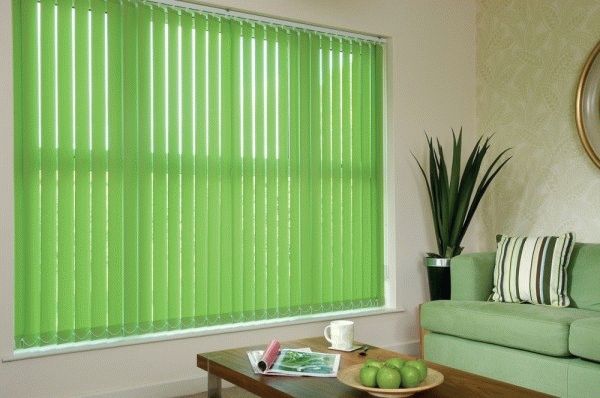

Rolled. Thanks to the variety of colors, these blinds are perfect for any design solution.
They perform the same functions as simple horizontal blinds, but the fabric base itself makes them lighter and more graceful. They are attached simply - on adhesive tape, using self-tapping screws, which are screwed to glazing beads or brackets.
Views
There are several types of construction, the installation of which does not use self-tapping screws.
- Roller blinds. It is a smooth fabric that is rolled into a roll using a special mechanism.
- Horizontal. The second name is "Venetian shutters". Their canvas consists of horizontal slats. They are usually made of aluminum, plastic, or wood.
- Pleated curtains. Instead of lamellas, they use one-piece fabric with folds.
- Vertical. They are a rail with vertical lamellas. They are often placed above the opening and serve as curtains.
Do-it-yourself measurements
Expert opinion
Mikhailova Maria Vasilievna
Furniture store manager. Knows everything about comfort and interior
Taking measurements so that the installation of blinds on a plastic window is successful is not particularly difficult, but it has some features that cannot be overlooked.
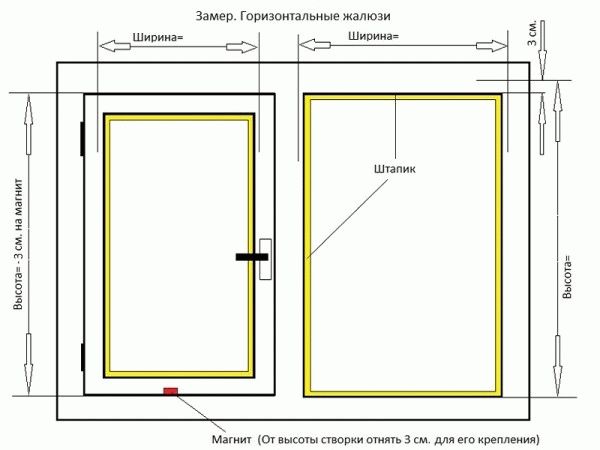

If the choice has settled on vertical blinds, then special attention should be paid to the width of the product. Unfortunately, adding an extra record will be much more difficult than, say, shortening it. As a result, after adding at least one plate, you will have to redo the entire product as a whole.
If you decide to hang horizontal curtains, then there are several options for both fixings and measurements.
To attach the blinds inside the window, you need to know the width and height of the product. Of course, the height can be adjusted later using the built-in mechanism, but it is better to calculate it as accurately as possible so that the excess does not "roll" on the window sash with unnecessary weight.
Width is the measurement that requires special attention, because depending on the accuracy of its removal, the window will be completely closed or sunlight and unnecessary noise will break through the cracks left.
If the window opens, then measurements should be made in the following way. Take accurate measurements of the height and width of the glass itself, and then add 2 cm on top and 0.5 cm on the sides. It is necessary to take into account the presence of window fittings, which should not interfere with the operation of the blinds.
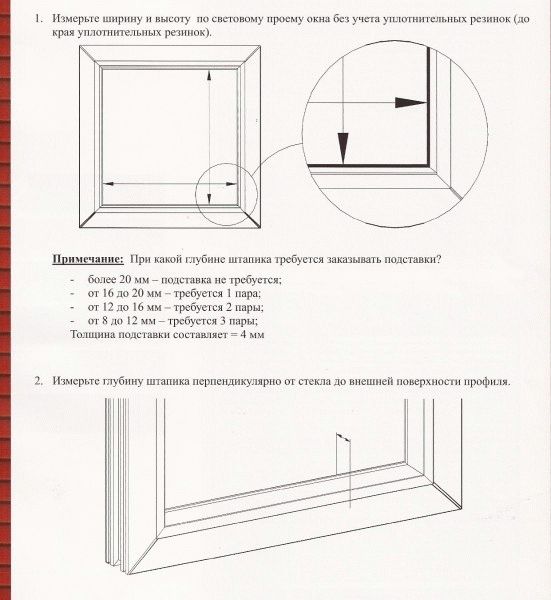

According to the same principle, measurements are made for roller blinds.
Of course, you can remove the dimensions, calculate the number of strips, make or purchase materials of the required dimensions yourself.
But does it take so much effort and time? Buy brackets, adhesive tape, glazing beads and more? It is much easier with your size to come to the company and select the product of interest.
How to choose blinds
When choosing blinds for your apartment, you need to carefully select the material, color and texture in order to harmoniously fit this type of curtain into the living space. If you have a glazed balcony, then plastic or aluminum blinds will be the only correct solution for balcony windows.
An important advantage of blinds is their compactness, heat and sound insulation. When using this type of curtain, your window sill is freed. You can save a lot on electricity consumption, since the blinds protect the living space from excess sunlight and heat. In summer, the air conditioner will operate in a more economical mode. Now you can buy structures not only from plastic and aluminum, but from bamboo and wood.
Vertical blinds are often treated with special dust-repellent solutions.This design can be rolled up and washed in the washing machine or by hand.
Quite an interesting look for interior decoration of pleated curtains. Pleated blinds are made of pleated fabric and are attached directly to the window. Close such curtains with a cord.
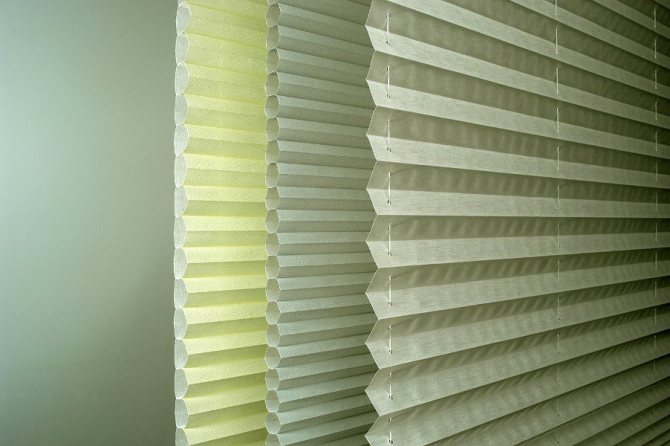

Pleated blinds
The most sophisticated and expensive look is for wooden blinds. Wooden plates do not rattle, have a natural structure, protect the room from light and do not heat up. They ennoble the room and fit into any interior, suitable for both offices and bedrooms. They are made from Canadian linden and cork.
You can also choose multi-textured blinds - a combination of plastic and fabric. Vertical plastic blinds are made curly, because of this, the whole room is filled with various light reflections. They look like curtains made of airy fabrics.
New on the market - photo blinds. Any pattern is applied to the white lamellas, and when you open the blinds, you can admire a beautiful picture.


Photo blinds
Japanese curtains are a combination of several fabric panels made from fabrics or plastic. They move along the cornice with different guides, they can move and move apart.
You can always change the outfit for your windows by purchasing new blinds - and your room has been updated without repair. Carefully consider the choice of the color of the curtains, paying attention to the colors of the furniture in the room.

